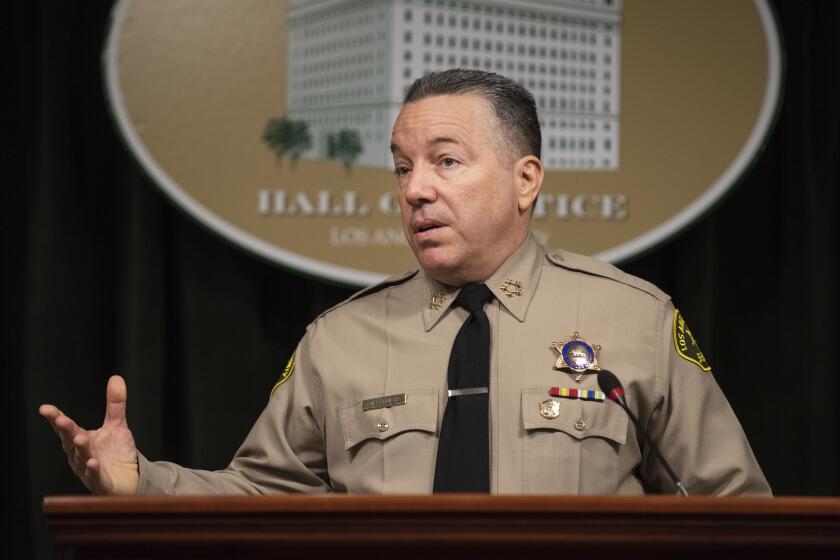New West L.A. skateboard plaza is a dream for riders, a disruption for residents
When a tricked-out concrete skate plaza designed in part by local skateboard pros opened at a West Los Angeles city park in July, it was a dream come true for sk8er dudes and dolls.
But apartment dwellers across the street from the Sawtelle-area Stoner Skate Plaza at Stoner and Nebraska avenues say the slides and grinds of skateboarders who disregard posted hours have shredded their dreams of a good night’s sleep. Forget about a Sunday afternoon nap.
With the number of urban skate parks and plazas on the rise in Los Angeles and elsewhere, such clashes over carving and kickflips are likely to become more common. As skateboarders successfully lobby cities for more safe spots where they can pop their ollies and nollies, often without supervision, hostility from residents can boil over.
Indeed, the office of Councilman Bill Rosendahl, who represents the area that includes Stoner Recreation Center and its new skate plaza, has been hearing plenty from neighbors such as Mindy Glazer. The 15-year resident said she often has been awakened at 3 or 4 a.m. “by an intrusive, ugly clacking” and that she has summoned police just about every night since the park opened to roust after-hours skaters.
Another woman who tried to shush skateboarders in the wee hours said one later rode his board over her apartment steps. Some residents declined to speak on the record, saying they feared reprisals.
Glazer said she keeps her doors and windows closed, even on days when she would like to let in a pleasant breeze. One neighbor, recovering at home from an illness, has tried to baffle the noise by duct-taping wadded-up plastic bags and egg-crate foam to his windows. Dagmar Spira, who owns and lives in a building a block away, said one of her tenants moved because of noise.
Construction of the $1-million skate plaza, built with developer fees, was intended in part to force out members of the Sotel gang who had long hung out at the park, according to residents. Rosendahl said the plaza and other improvements such as lights have enhanced the park.
But residents were upset the skate park grew to 20,000 square feet from its original 14,000, though some said that at least the Sotel members were quiet.
“We have a new kind of gang,” said Patty Roque, referring to the skateboarders she can see and hear from her balcony. “We don’t want to rock the boat, but we want peace. I want my quiet.”
“I don’t skate at night,” said Amir Tillard, 19, a Santa Monica College student practicing his moves at Stoner. “I skate till they tell me it’s time to go.” He said residents should expect noise in a city.
Rosendahl defended the plaza, saying it was a boon to young people who otherwise would be skateboarding on streets or sidewalks or at schools, malls and municipal facilities. Until a few years ago, he said, skateboarders routinely chugged over the metal railings and concrete steps at the West Los Angeles Civic Center, just west of the 405 Freeway. Neighborhood council members threatened to lay down strips to halt the practice. Skaters asserted they needed someplace else to go.
One recent afternoon, Tillard was among three dozen skaters and scooter riders — from tots to men in their 20s and a lone female — honing their techniques. Only a 10-year-old boy, a newbie under the supervision of his father, sported a helmet and pads.
Carlos Romero, 18, in black T-shirt, jeans and baseball cap, repeatedly attempted to jump his board over the gap between two ledges as his friend Carlos Gil, 16, shot video of the trick for YouTube. The two usually skate in South L.A. or Long Beach but have made two visits to Stoner. “It’s a pretty easy skate,” Romero said. “It’s fun.”
According to industry websites, studies have shown that concrete is quieter than wood or metal. Stoner “reflects the most modern thinking in skate park design, which is to replicate in great detail what we would consider the natural skating environment,” said Miki Vuckovich, executive director of the Tony Hawk Foundation, which helps fund skate parks in low-income neighborhoods. Among the features are stairs, handrails, hip ramps and manual pads, which mimic fixtures in the urban landscape.
Jay Handal, chairman of the West Los Angeles Neighborhood Council, said the noise has subsided since the plaza’s early days. In an effort to muffle some sound, he said, plans call for filling the hollow metal railings with sand. Any other efforts to reduce noise, he said, will be on hold until the Los Angeles Police Department conducts a 24-hour noise level test.
Rosendahl said he also has proposed shorter hours for the skate plaza: 10 a.m. to 7:30 p.m. during periods of daylight-saving time and 10 a.m. to 5:30 p.m. the rest of the year. He said police would issue citations if necessary.
“The kids weren’t very happy,” he said, “but they understand the neighbors matter.”
martha.groves@latimes.com
More to Read
Sign up for Essential California
The most important California stories and recommendations in your inbox every morning.
You may occasionally receive promotional content from the Los Angeles Times.











